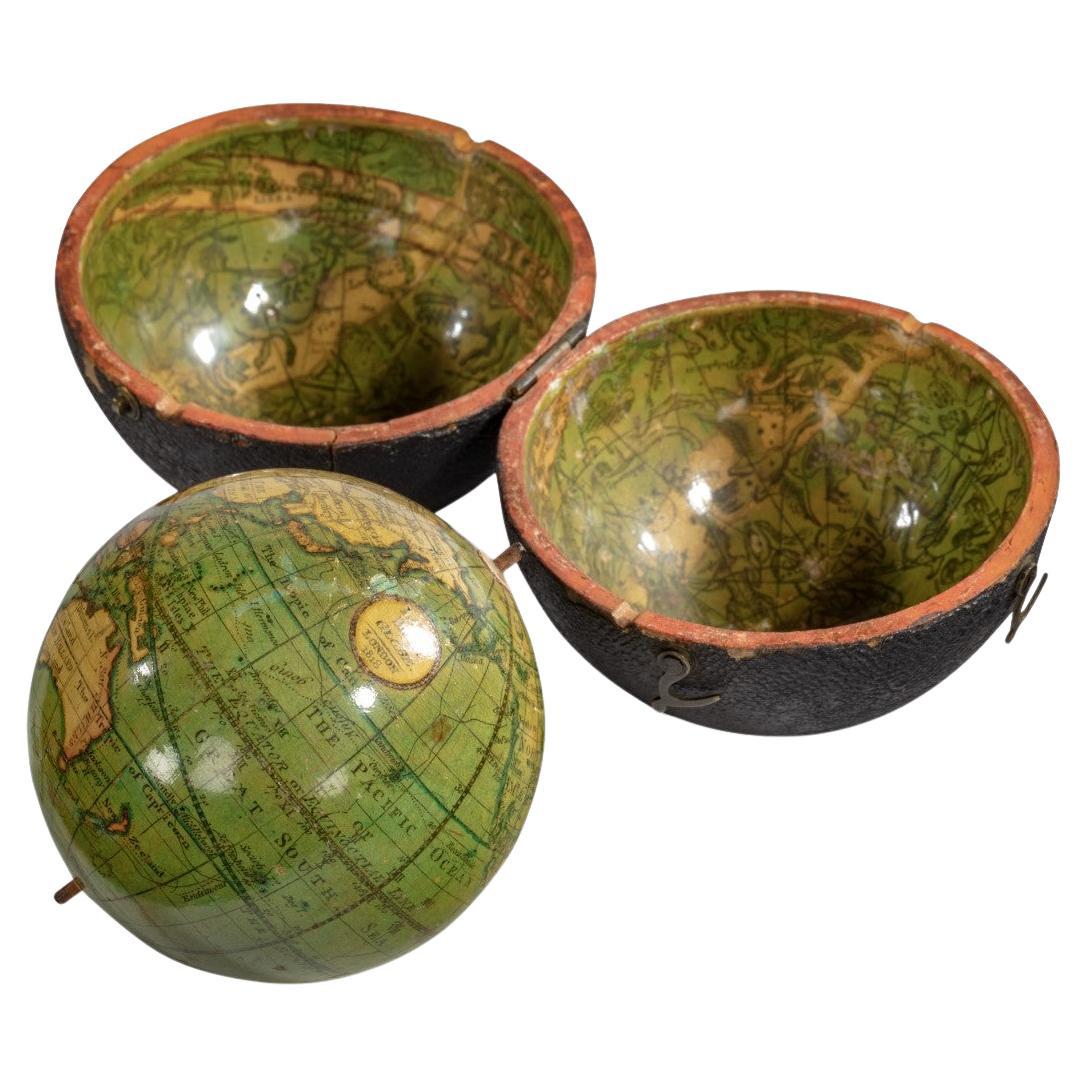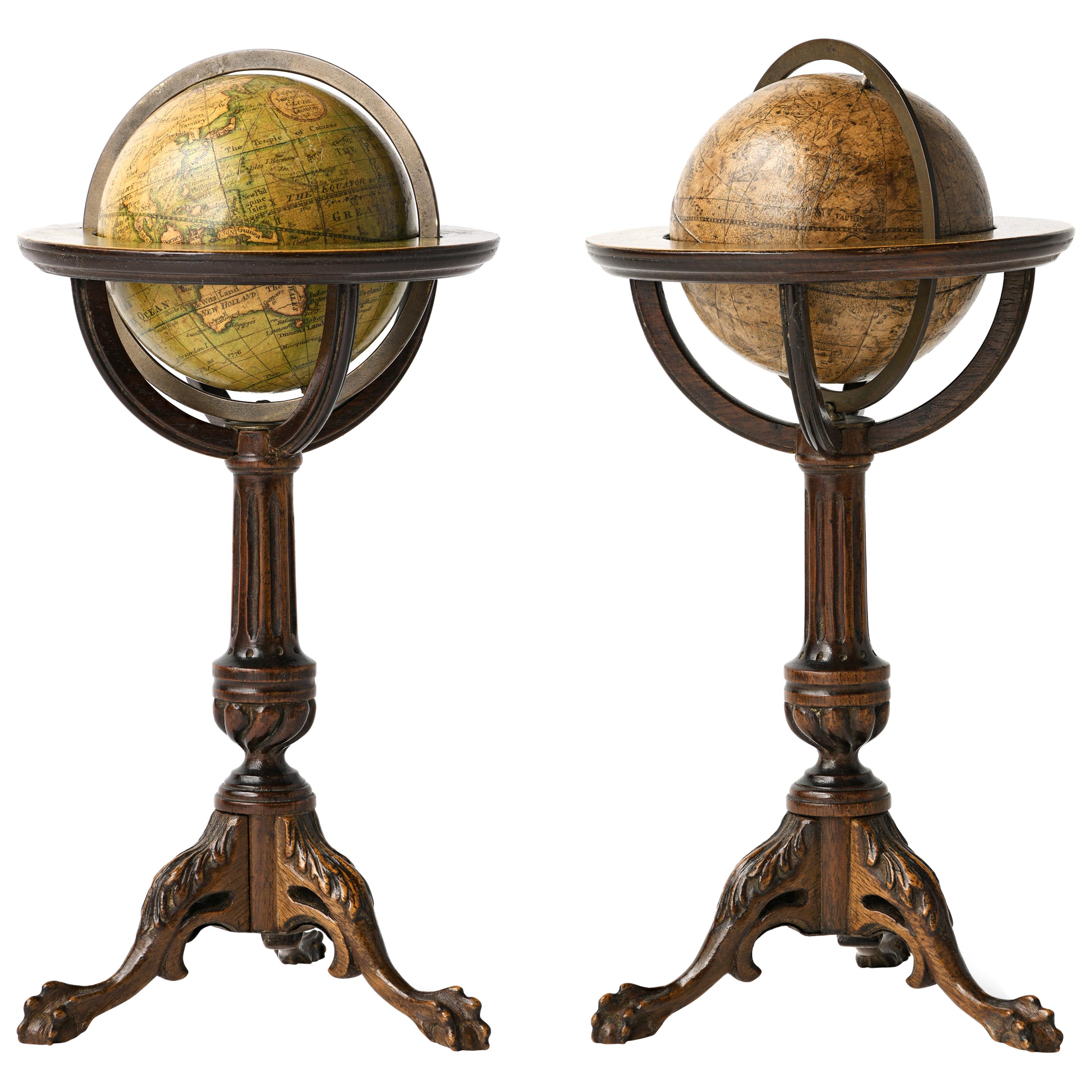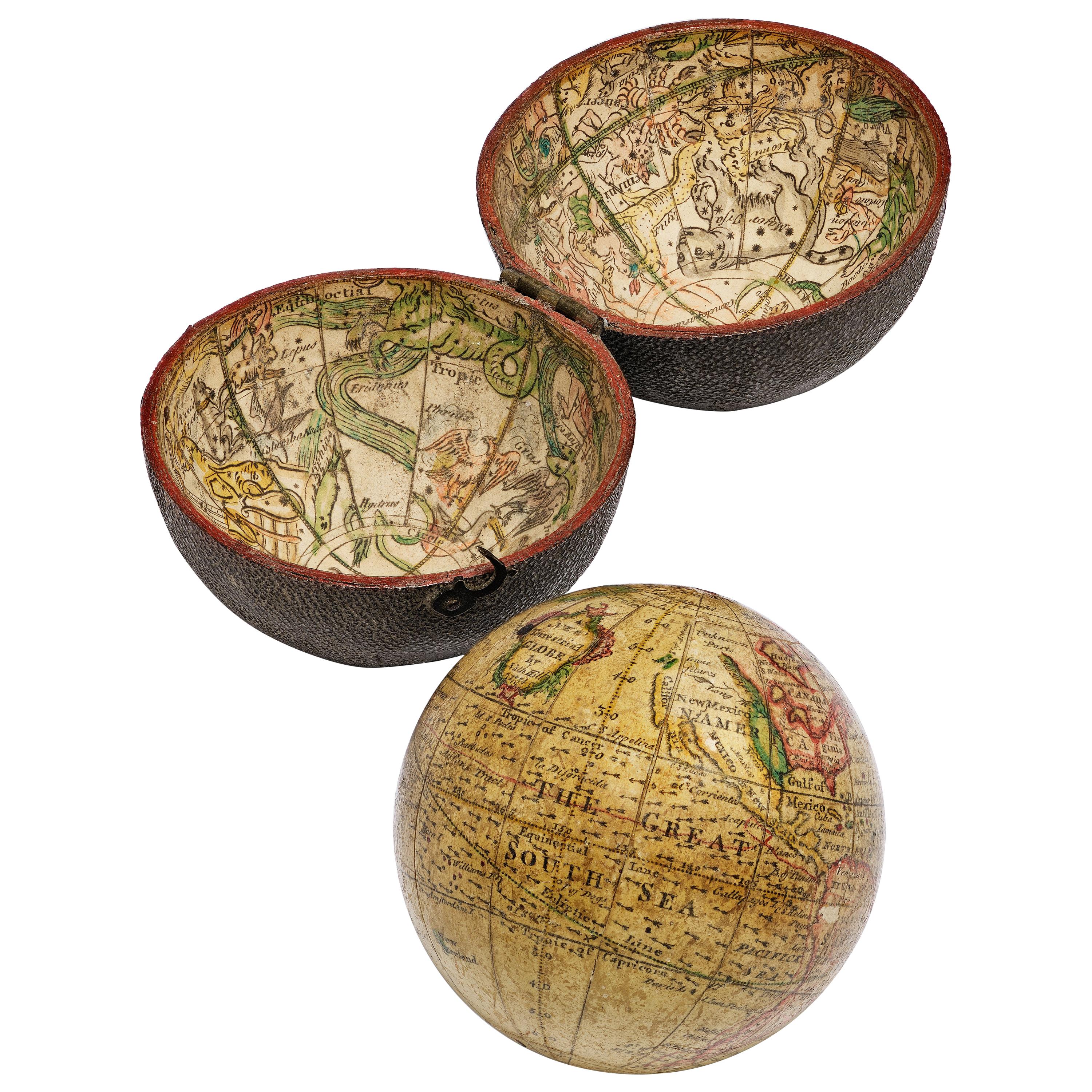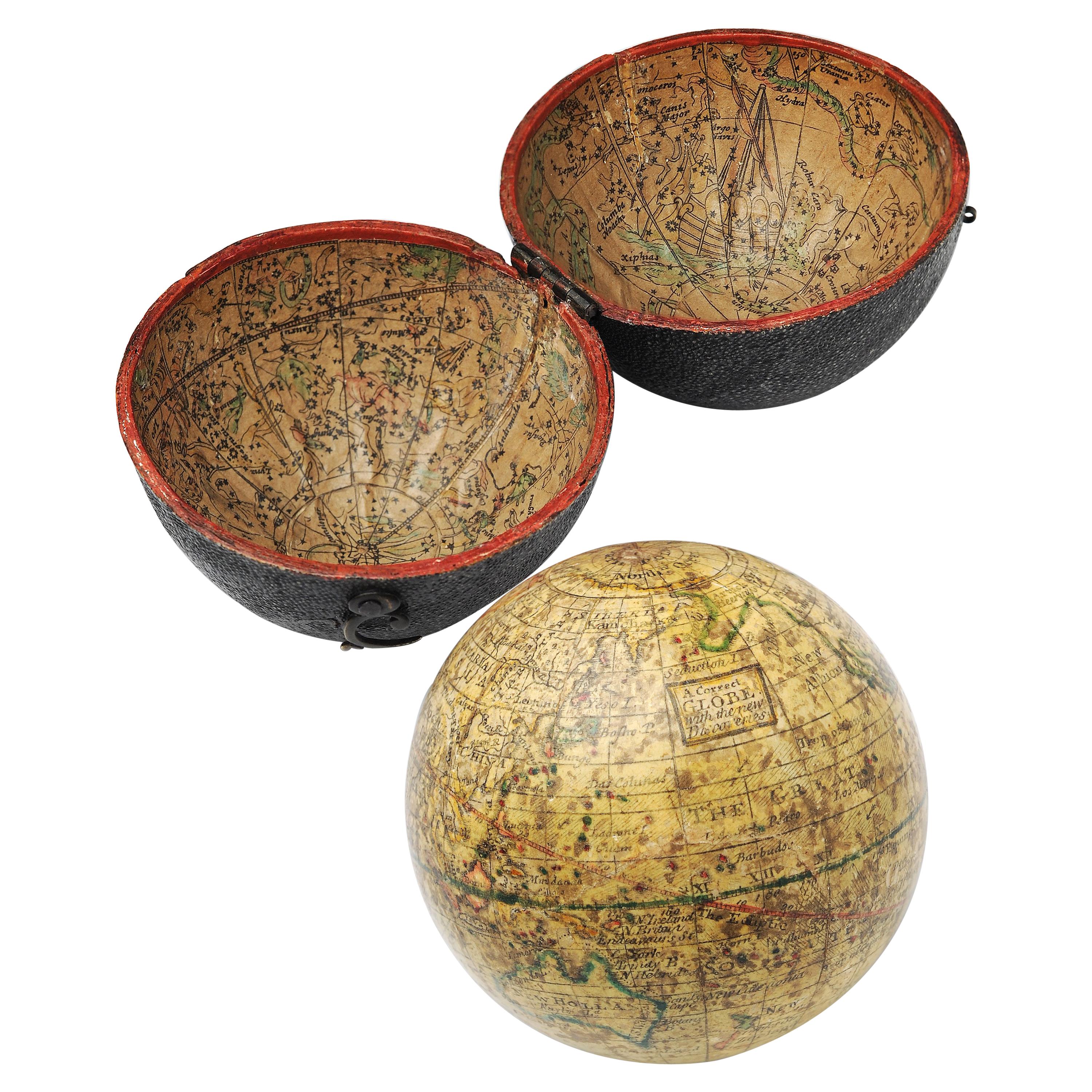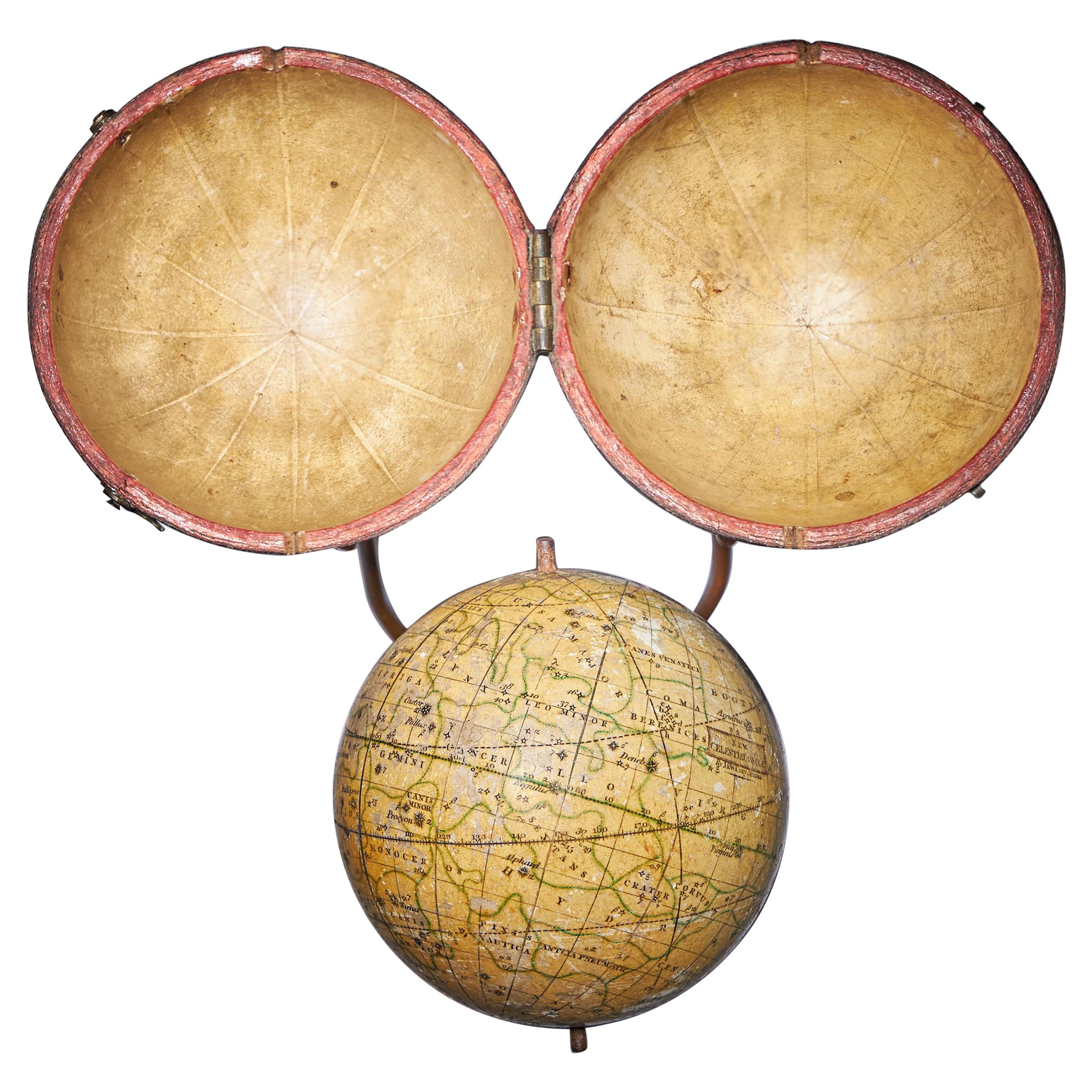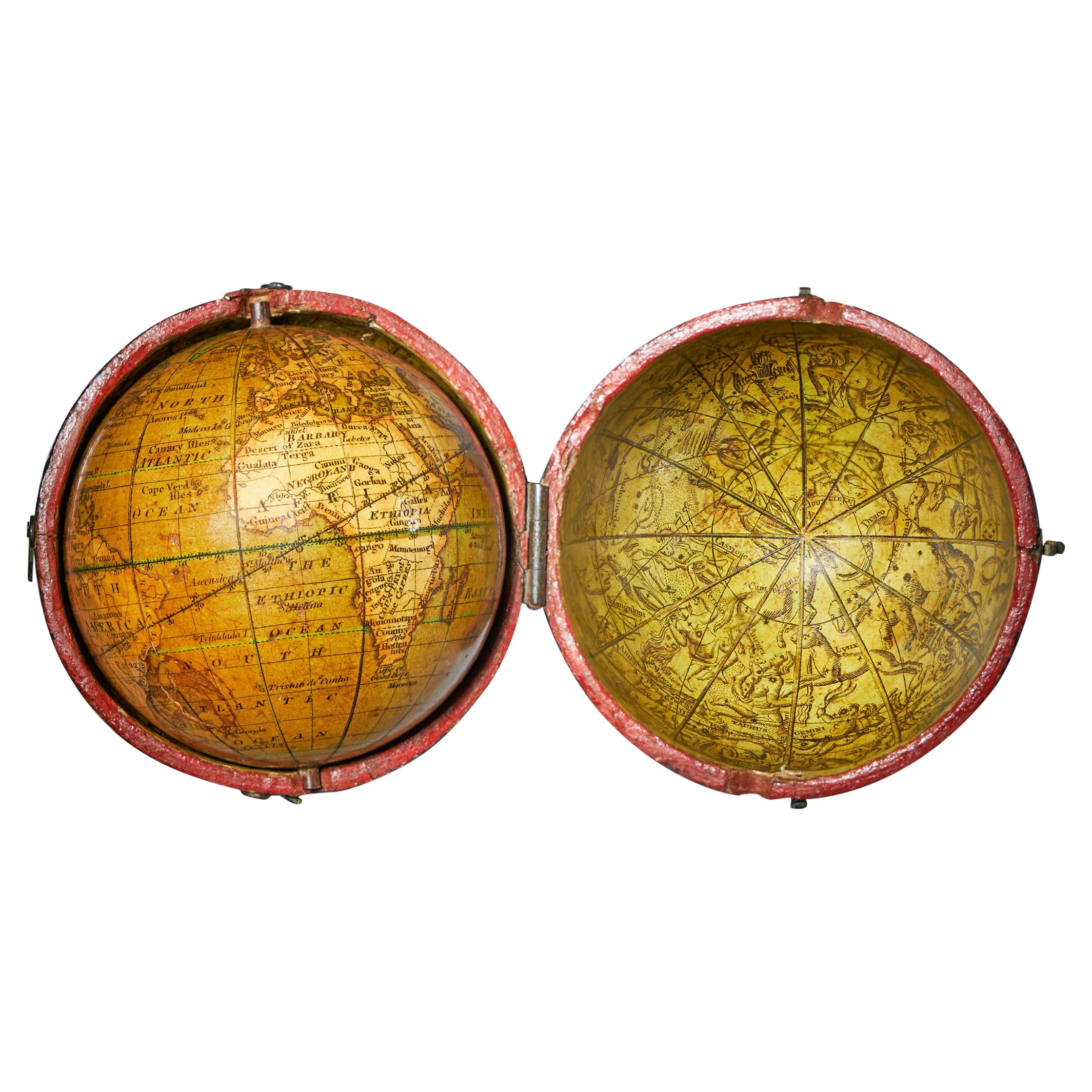Items Similar to Pocket Globe, Nicholas Lane, London, post 1779
Video Loading
Want more images or videos?
Request additional images or videos from the seller
Pocket Globe, Nicholas Lane, London, post 1779
About the Item
Pocket Globe
Nicholas Lane
London, post 1779
The globe is contained in its original case, which is covered in leather.
The sphere measures 2.75 in (6.9 cm) whereas the case measures 2.9 in (7.5 cm).
Weight: 0.28 lb (128 g).
State of conservation: almost excellent. It has some slight abrasions and a few signs of use. The case doesn't close completely.
The globe is made up of twelve printed paper gores aligned and glued to the sphere. On the Poles, two pins had been inserted, but these are now missing.
In the North Pacific Ocean, above the Tropic of Cancer, the globe bears a cartouche framed with small leafy branches. It contains the inscription:
A New
GLOBE
of the EARTH
by N. Lane
and, below the cartouche, there is:
1776 Prockter fc.
On the terrestrial globe, a large part of southern and central Africa is empty, and the Great Lakes Tanganyika and Victoria (which Europeans would begin to explore after 1858) are not marked. North America only bears the names of some British colonies. California is already depicted as a peninsula, but the northern territories of the continent are inaccurately represented: Alaska is barely described, and the northeastern coasts appear to be connected to Greenland. Australia, which bears the old name of New Holland (the new name would be introduced after 1824), is fully depicted, while Tasmania still appears as a peninsula. It was circumnavigated by Matthew Flinders in 1798.
In the South China Sea and the Indian Ocean, the directions of the monsoons are indicated. The Great Wall of China is also depicted on the map.
Some of the routes of the voyages of Anson and Cook are traced on the map. The pocket globe was likely created after the death of Captain Cook on February 14, 1779, as his place of death, Kealakekua Bay in the Hawaiian Islands, is marked on the map. It is indeed likely that the publication of the pocket globe took place in the period immediately following Cook's disappearance. By the time the two ships of his expedition returned to England in October 1780, the news of his demise had already been known for some time. (Nigel Rigby and Pieter van der Merwe, Captain Cook in the Pacific, London 2002, p. 61) This event surely would have sparked competition among publishers, leading to an accelerated update of maps and globes to be published.
The container is made up of two hemispheres covered in black leather and hinged together. Two hooks ensure its closure.
Inside the two hemispheres, the celestial vault is depicted, with stars and constellations indicated in both Latin and English. Many of them are represented by their corresponding mythological figures.
The current state of research does not allow for the reconstruction of the entire history of the Lane family. They were manufacturers of globes - especially pocket-sized ones - and the founder of the company in the 1770s was almost certainly Nicholas (perhaps a relative of John I, John II or James, all of whom were active in manufacturing scientific instruments for other entrepreneurs, starting from 1733); his son Thomas continued the business until at least the early decades of the nineteenth century. Then it is not clear which family members took over the management of the company. Sources have so far provided the names (George, John), but not the kinship relationships between them; the only certain fact is that the production of Lane branded globes continued until about the middle of the 19th century.
Bibliography:
P., Van der Krogt, Old Globes in the Netherlands, Utrecht 1984, pp. 180-182;
G. Clifton, Directory of British Scientific Instrument Makers 1550-1851, London 1995, s. v.;
E., Dekker, Globes at Greenwich, Oxford 1999, pp. 393-394;
Nigel Rigby and Pieter van der Merwe, Captain Cook in the Pacific, London 2002.
- Creator:Nicholas Lane (Author)
- Dimensions:Height: 2.72 in (6.9 cm)Diameter: 2.72 in (6.9 cm)
- Style:Other (Of the Period)
- Materials and Techniques:
- Place of Origin:
- Period:1780-1789
- Date of Manufacture:Circa 1779
- Condition:Wear consistent with age and use. It has some slight abrasions and a few signs of use. The case doesn't close completely.1200.
- Seller Location:Milano, IT
- Reference Number:1stDibs: LU4352238406382
About the Seller
4.3
Vetted Seller
These experienced sellers undergo a comprehensive evaluation by our team of in-house experts.
Established in 1860
1stDibs seller since 2018
19 sales on 1stDibs
Typical response time: 1 hour
Associations
International Confederation of Art and Antique Dealers' Associations
- ShippingRetrieving quote...Ships From: Milano, Italy
- Return PolicyA return for this item may be initiated within 14 days of delivery.
More From This SellerView All
- Pair of Miniature Globes Lane’s on Tripod Bases, London post 1833, ante 1858By Lane'sLocated in Milano, ITPair of miniature globes Lane’s, London, post 1833, ante 1858 Papier-mâché, wood and paper They measure: Height 9.44 in (24 cm); Sphere diameter 2.75 in (7 cm); Diameter of t...Category
Antique 1840s English Early Victorian Maps
MaterialsPaper, Wood
- Pocket Globe by Nathaniel Hill, London 1754Located in Milano, ITNathaniel Hill Pocket globe London, 1754 The globe is contained in its original case, which itself is covered in shark skin. There are slight gaps in the original paint on the sphere. The case no longer closes. The sphere measures 2.6 in (6.8 cm) in diameter whereas the case measures 2.9 in (7.4 cm) in diameter. lb 0.24 (kg 0.11) The globe is made up of twelve printed paper gores aligned and glued to the sphere. In the North Pacific Ocean there is a scroll with the inscription: A New terrestrial Globe by Nath. Hill, 1754. The celestial globe is depicted on the inside of the box. On the terrestrial globe much of central and southern Africa is empty. North America bears only the name of some British colonies. It shows California as a peninsula and the northwest coast of America as "unknown parts" (Alaska is not described and is only partially delineated; it would become part of the United States in 1867). The route of Admiral Anson is traced (1740) and the trade winds are indicated by arrows. Australia, still named New Holland (the new name would be introduced in 1829), is part of the west coast. (See Van der Krogt, P., Old Globes in the Netherlands, Utrecht 1984, p. 146 and Van der Krogt, P. - Dekker, E., Globes from the Western World, London 1993, p. 115.) Nathaniel Hill (London, news from 1746 to 1768) had impeccable professional credentials: he had done his apprenticeship with Richard Cushee, who at the time was carrying out surveying work for John Senex's Surrey map...Category
Antique 1750s English George II Globes
MaterialsShagreen, Paper
- English Pocket Globe, London, Circa 1775-1798By Herman MollLocated in Milano, ITPocket globe London, between 1775 and 1798 Re-edition of the globe of Hermann Moll (1678-1732) dated 1719 The globe is contained in its original case, which itself is covered in sh...Category
Antique Late 18th Century English George III Globes
MaterialsShagreen, Paper
- Miniature Terrestrial Globe Newton & Son London, Post 1833, Ante 1858By Newton and SonLocated in Milano, ITMiniature Terrestrial Globe Newton & Son London, post 1833, ante 1858 Paper, papier-mâché, bronze and wood It measures: sphere diameter 2.95 in (7.6 cm); diameter of the wooden base 6.02 in (15.3 cm); height 8.36 in (21.24 cm). Weight: 2,067 lb. State of conservation: the globe still bears its original paint, but has various small gaps, abrasions and stains on the surface. The globe is hinged with two pins at the meridian circle, which is in turn inserted perpendicular to the horizon circle; this is supported by four semi-arches connected at the bottom by a small goblet-shaped foot, resting on a wooden bell-shaped base. Apart from the wooden base, the entire support structure is made of bronze; on the foot there are the scale reproductions of a compass, a telescope and an open book. The sphere is made of papier-mâché and is covered with twelve printed paper gores. In the North Pacific Ocean the globe bears a cartouche with the inscription (about 30% of the writing is illegible, but the missing parts can be easily integrated based on the rest): NEWTON’S New & Improved TERRESTRIAL Globe Published by Newton & Son 66 Chancery Lane LONDON On the globe, much of central Africa is empty and the great lakes Tanganyika and Victoria are not marked (Europeans would begin to explore the area after 1858). Canada is called "British Territory" and Alaska "Russian Territory" (it would become part of the United States in 1867). Australia already bears its modern name (until 1829 it had been called New Holland) and its coasts are completely designed; Tasmania is listed as an island (Matthew Flinders circumnavigated it in 1798). The routes of Cook's various voyages are plotted; both the route followed by Biscoe in 1831 and the "Land of Enderby" which he discovered on the coast of Antarctica, south of Africa, are marked. Bibliography P. Van der Krogt, Old Globes...Category
Antique 1840s English Early Victorian Maps
MaterialsBronze
- 18-inch Globe, Cary's, London, 1840By Cary’sLocated in Milano, ITJohn and William Cary Updated by George and John Cary Terrestrial Globe London, 1840 lb 22 (kg 10) Slight surface abrasions due to use. A small crack on the horizon circle. The globe rests in its original Dutch style stand with four supporting turned wood columns. It measures 26 in in height x 23.6 in in diameter with the diameter of the sphere measuring 18 in; 66 cm in height x 60 cm in diameter with the diameter of the sphere measuring 45.72 cm. The 18 inch...Category
Antique 1840s English Early Victorian Globes
MaterialsWood, Paper
- Pair of English Globes by Cary, London, 1798 and 1800By Cary’sLocated in Milano, ITPair of 12-inch table globes John and William Cary London, 1798 and 1800 Some restored cracks and abrasions lb 11 each (kg 5) The two terrestrial and celestial globes rest in their original Dutch style stands with four supporting turned wood columns. Each one measures 18 in in height x 17 in in diameter with the diameter of the spheres measuring about 12 in; 46 cm in height x 43 cm in diameter x 31 cm diameter of the spheres. The 12 inch measure was one of the most frequently used by British manufacturers of globes of this period. Each globe is composed of two series of twelve printed paper gores, aligned and glued onto plaster spheres. The brass circle of the meridian bears engravings...Category
Antique Late 18th Century English George III Globes
MaterialsWood, Paper
You May Also Like
- Regency Lane’s Pocket Globe, Dated 1818By Lane'sLocated in Lymington, HampshireA 3 ½ inch Regency Lane’s pocket globe, dated 1818, the terrestrial globe with the seas in light green and the land masses outlined in darker green, contained within a hinged black shagreen case, the concave interior of the case applied with the engraved celestial charts...Category
Antique 1810s English Regency Globes
MaterialsWood
- Rare George III Celestial Pocket Globe by Cary, LondonBy CaryLocated in Oxfordshire, United KingdomA fine and rare 3" celestial pocket globe by G & W Cary, Strand, London circa 1791, housed in its original sharkskin case. A companion globe to terrestrial globes of this type we...Category
Antique Late 18th Century English George III Aviation Objects
MaterialsPlaster
- Georgian Terrestrial Pocket Globe by T. Harris and Son, London, 1813Located in Oxfordshire, United KingdomA Rare George III pocket globe by T. Harris and Son, London, 1813. Housed in the original sharkskin case. A fasinsting and rare item in wonderful condition. The terrestrial globe inscribed 'New Terrestrial Globe By T.Harris and Sons 1813' rotates on its axes inside a hinged black shagreen case. The concave interior of the case applied with the engraved celestial charts of the Northern and Southern skies and depictatioins of the symbols of Zodiac. The Harris family — Thomas Harris (d. 1837) and his son William Harris (1797-1846) — were London opticians who also sold and later produced terrestrial and celestial globes. Initially, Thomas Harris was principally an optician and mathematical instrument maker. He was joined, and then succeeded, by William in...Category
Antique Early 19th Century English George III Aviation Objects
MaterialsPlaster
- A Fine Example of 3" Pocket Globe by Lane, LondonLocated in Lincolnshire, GBA very clean and original example of a Lane 3" pocket globe in the original Morocco red leather case, with the celestial papers inside the case. G...Category
Antique 19th Century English Globes
MaterialsLeather, Paper
- George III Pocket Globe After Herman MollBy Herman MollLocated in Lymington, HampshireA 3 inch George III pocket globe after Herman Moll, the terrestrial globe inscribed in a cartouche ‘A correct globe with the new discoveries’ and fitted within a hinged black shagreen case, the concave interior of the case applied with the engraved celestial charts...Category
Antique 1770s English George III Globes
MaterialsWood
- 19th Century German Miniature Pocket Terrestrial GlobeBy C. Abel-KlingerLocated in Essex, MAA miniature 19th century 3.5 inch diameter pocket terrestrial globe by C. Abel-Klinger, Nuremberg, Germany, in English for the English speaking markets. Signed with cartouche reading...Category
Antique 1880s German Scientific Instruments
MaterialsBrass
